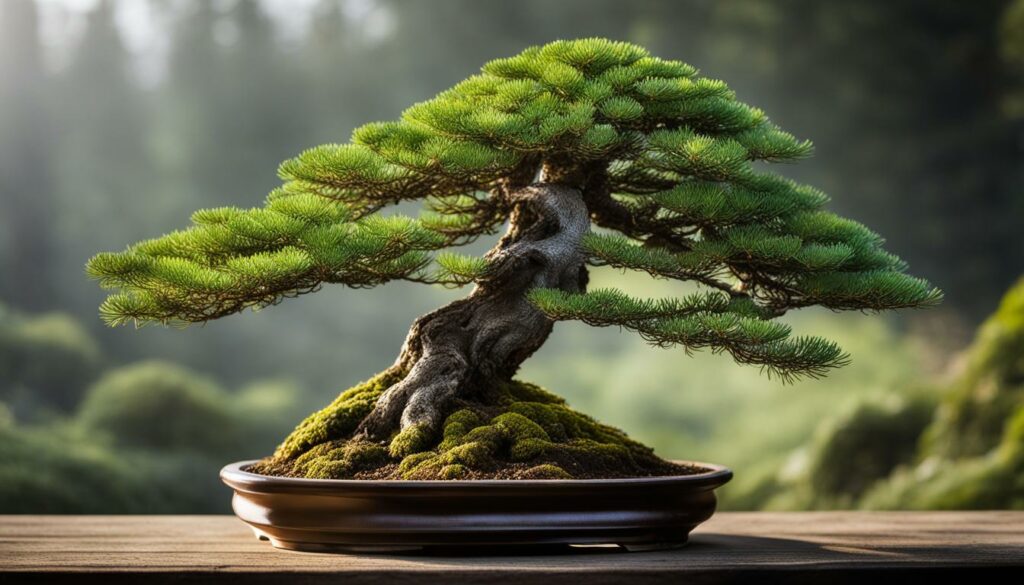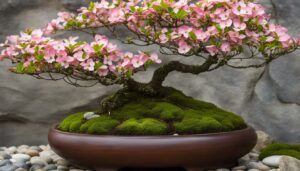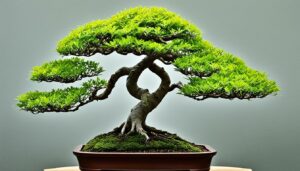If you’re looking for a Bonsai tree species that exudes elegance and nobility, look no further than the Spruce Bonsai. The Spruce bonsai tree (Picea genus) is a popular choice for bonsai enthusiasts due to its unique characteristics and visually striking appearance.
The Spruce Bonsai, like other Bonsai tree species, has its own specific care requirements to ensure its health and longevity. In this section, we’ll take a closer look at the Spruce Bonsai, its natural habitat, and its different varieties commonly used for Bonsai, as well as providing some valuable tips for cultivating and maintaining your own bonsai tree.
Key Takeaways:
- The Spruce Bonsai is a visually striking and elegant addition to any Bonsai collection or outdoor landscape.
- Proper Spruce Bonsai care requires attention to specific watering, light exposure, temperature, and soil composition needs.
- Choosing the right pot and pruning and shaping techniques are also crucial for maintaining the miniature form of your Bonsai tree.
- Spruce Bonsai is prone to common pests and diseases that require prompt identification and treatment for plant health.
- Incorporate the Spruce Bonsai into your landscape design for a unique and impressive focal point or accent
Understanding the Spruce Bonsai Tree Species
When it comes to Bonsai Tree Species, the Spruce is a favorite because of its unique beauty and hardiness. Understanding the Spruce Bonsai Tree species is the first step to successfully caring for this elegant miniature tree.
The Natural Habitat of Spruce Bonsai Trees
The Spruce tree species is found in the temperate regions of the Northern Hemisphere. It grows well in mountainous areas and is commonly found in North America, Europe, and Asia. Spruce bonsai trees require a cool, moist environment and prefer partial sun to full sun exposure.
Growth Patterns of Spruce Bonsai Trees
Spruce Bonsai Trees grow in a pyramid or conical shape, with branches that spread out in a horizontal pattern. This gives the tree a full and robust appearance, making it a popular choice for bonsai enthusiasts. Additionally, spruce trees are known for their dense foliage, which provides the perfect canvas for shaping and pruning into different styles and designs.
| Spruce Bonsai Tree Varieties | Description |
|---|---|
| Norway Spruce (Picea abies) | This variety has shorter needles and a lighter green color than other spruce trees. It also has a flatter crown, making it perfect for carving unique shapes and designs. |
| Colorado Blue Spruce (Picea pungens) | This variety has a bluish-green color and longer needles than other spruce trees. It has a more pyramidal shape than the Norway spruce, making it a popular choice for creating formal bonsai styles. |
| Serbian Spruce (Picea omorika) | This variety has shorter needles and a narrow, conical shape. It is a slow-growing tree, making it ideal for smaller bonsai designs. |
Each of these spruce bonsai tree varieties offers unique characteristics, making them suitable for different bonsai styles and preferences.
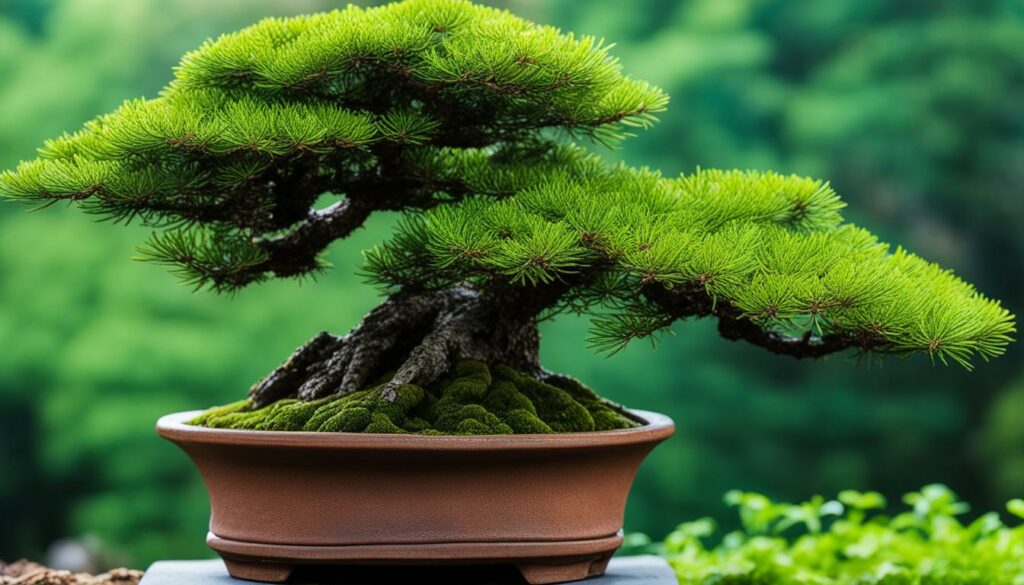
Spruce Bonsai Care: A Comprehensive Guide
Proper care is crucial for maintaining the health and aesthetics of your spruce bonsai. Follow these valuable tips to ensure your tree thrives:
Watering
Watering is one of the most critical aspects of spruce bonsai care. It is essential to strike a balance between moisture and drainage in the soil. Overwatering can cause root rot, while underwatering will cause the tree to dry up.
Water your spruce bonsai only when the soil feels slightly dry to the touch. Ensure good drainage by using soil that is coarse and well-draining, and a pot with drainage holes.
Light Exposure
Spruce bonsai thrives in bright, indirect light. Place your tree outdoors, in a spot that receives ample sunlight but is also protected from intense heat and wind. If you plan to keep your bonsai tree indoors, ensure that it gets adequate sunlight by placing it near a window that receives bright, indirect light.
Temperature
Spruce bonsai prefers cool temperatures and does well in cold winter climates with temperatures dropping below 50°F. Keep your tree away from heat sources such as radiators and heaters that can dry it out.
Soil Composition
Choosing the right soil composition is crucial for spruce bonsai care. A mix of akadama, pumice, and lava rock in equal parts is an excellent choice for bonsai trees. This soil mixture is porous and well-draining, allowing air to circulate freely around the roots.
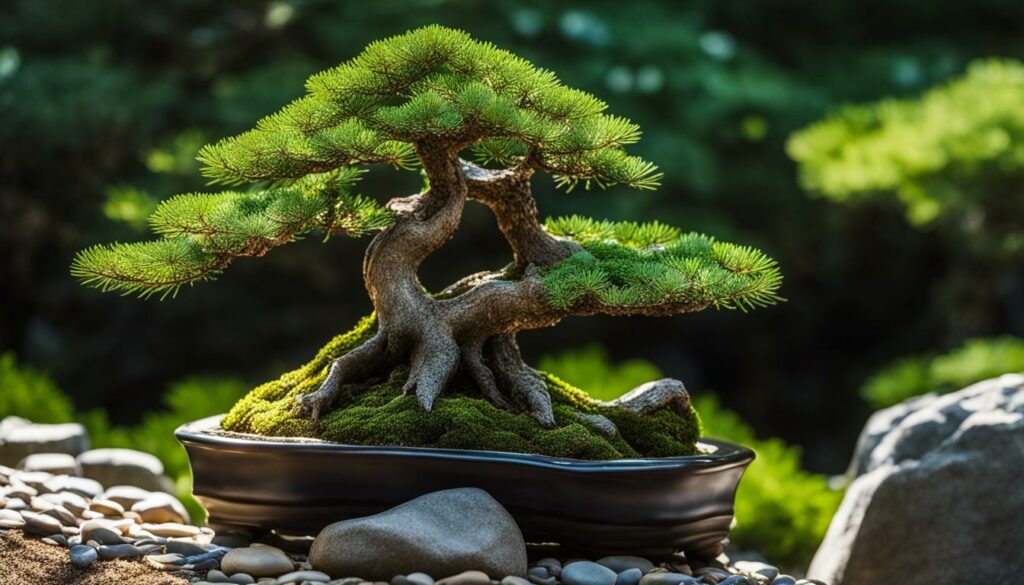
Pruning and Shaping
Pruning and shaping your spruce bonsai regularly is necessary to maintain its miniature form and aesthetic appeal. Use sharp bonsai scissors or shears to cut back growth and shape your tree.
Outdoor Placement
When placing your spruce bonsai tree outdoors, ensure that it is adequately protected from harsh weather conditions like extreme heat, heavy rain, or strong winds. Position your tree in a location where it receives ample sunlight and is sheltered from extreme weather conditions.
Pest and Disease Management
Common pests and diseases that can affect spruce bonsai include spider mites, aphids, and fungal infections. Regularly inspect your tree for signs of infestation or disease, and take necessary measures to control them. An organic insecticidal spray or neem oil can be used to control most pests.
Selecting the Right Pot for Your Spruce Bonsai
Choosing the right pot for your spruce bonsai is essential to ensure its health and longevity. The pot should provide adequate space for the roots to grow, proper drainage to prevent waterlogging, and complement the aesthetics of your miniature tree.
The size of your pot should be in proportion to the size of your tree. A pot that is too small can hamper root growth, stunting your bonsai’s growth, while a pot that is too large can lead to over-watering and root rot. A good rule of thumb is to choose a pot that is about two-thirds the size of your bonsai tree.
The material of your pot can also affect your bonsai’s health. Ceramic or clay pots are ideal as they are porous, allowing air and water to penetrate the soil, promoting healthy root growth. Plastic pots are not recommended due to their poor drainage and inability to breathe.
When it comes to drainage, ensure your pot has adequate drainage holes to prevent waterlogging. If necessary, cover the drainage holes with screen mesh to keep the soil from escaping while allowing water to flow freely.
Pro tip: If your pot doesn’t have drainage holes, drill them yourself.
Lastly, consider the aesthetics of your pot. Choose a pot that complements the natural beauty of your spruce bonsai. Also, consider the color of your pot; lighter colors reflect sunlight and keep your tree cooler in the hot summer months, while darker colors absorb more heat, keeping your tree warmer during the winter.
| Pot selection Tips: | Considerations: |
|---|---|
| Size of pot | Two-thirds the size of your bonsai tree, right proportion |
| Pot material | Ceramic or clay pots, porous |
| Drainage holes | Adequate drainage, cover holes with screen mesh |
| Aesthetics of pot | Complement natural beauty of the tree, lighter colors during hot summer months, darker colors during the winter |
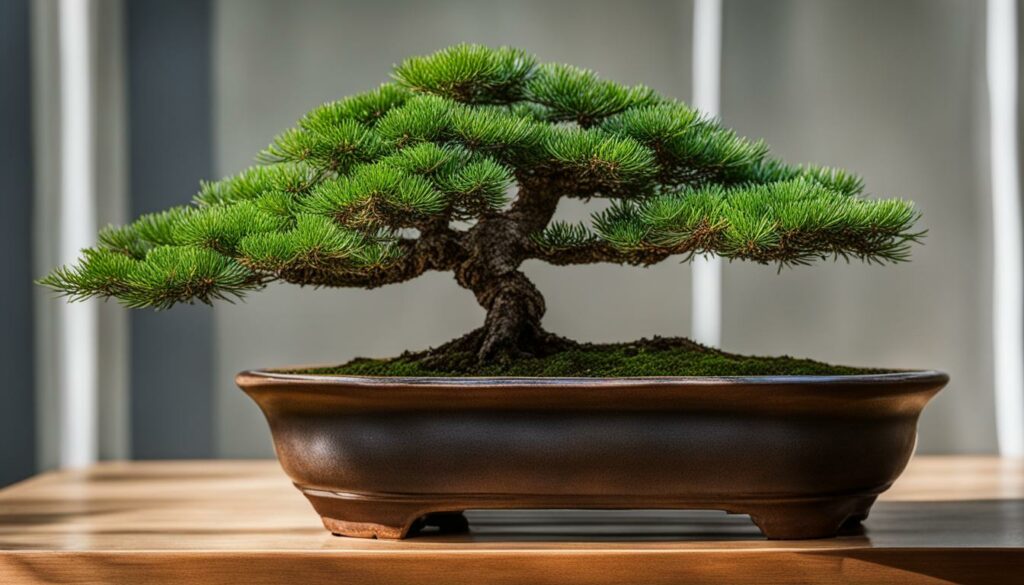
Tools and Techniques for Pruning and Shaping Your Spruce Bonsai
Pruning and shaping your spruce bonsai is an important aspect of its care. Proper pruning helps maintain the miniature size and shape of your tree, while shaping allows you to create unique styles and designs. To achieve optimal results, you will need the following essential tools:
| Tool | Description |
|---|---|
| Bonsai Scissors | Used for fine trimming and pruning of small branches and roots. |
| Bonsai Wire Cutters | Used for cutting and shaping the bonsai wire. |
| Bonsai Knob Cutters | Used for removing larger branches more smoothly and with less damage to the main tree. |
| Bonsai Concave Cutters | Used for cleanly removing branches without leaving unsightly scars or marks. |
Once you have the proper tools, you will need to follow these step-by-step instructions:
- Know the style: Before you start pruning, determine the style you want to achieve, such as formal upright, slanting, cascade, or semi-cascade.
- Remove unwanted branches: Use the bonsai scissors to remove unwanted branches or ones that interfere with the desired style.
- Thin out foliage: Thin out excess foliage to create a balanced and more open canopy.
- Wiring: To shape your tree, use bonsai wire to guide branches into the desired position.
- Remove wires: Once the branch is in position, remove the wire to avoid damaging the bark or branch structure.
- Monitor your tree: Regularly inspect your tree to ensure it is growing and shaping as desired.
With these tools and techniques, you can create a stunning and unique spruce bonsai tree. Don’t be afraid to experiment and get creative with your pruning and shaping. With practice, you can become an expert in creating elegant and miniature works of art.
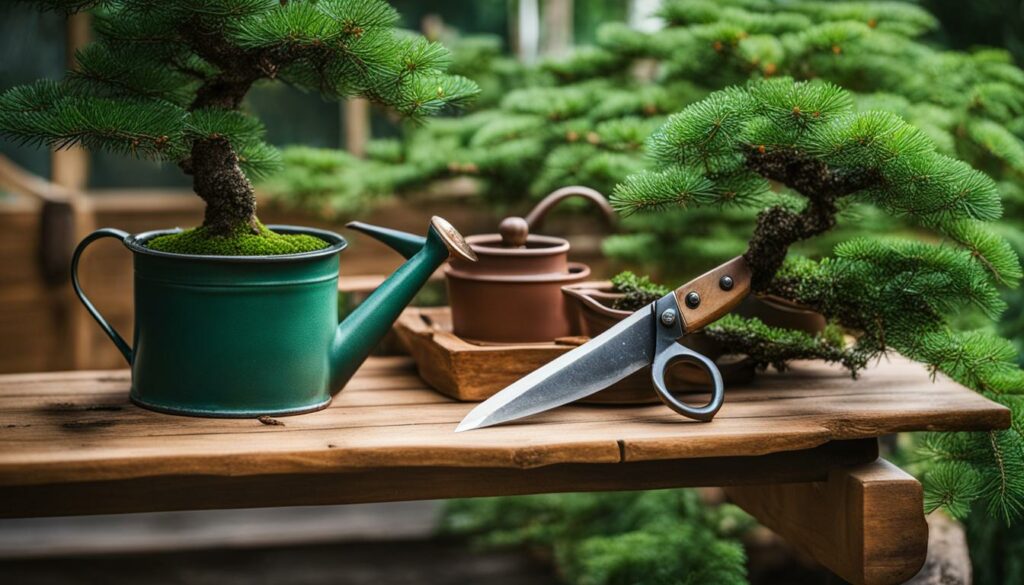
Outdoor Placement: Creating the Ideal Environment for Your Spruce Bonsai
When it comes to outdoor placement for your spruce bonsai, several key factors need to be considered. These factors include:
- Sunlight exposure
- Wind protection
- Temperature conditions
- Moisture levels in the soil
The ideal location for your spruce bonsai should receive ample sunlight, preferably in the morning or late afternoon. However, direct midday sunlight should be avoided, as it can damage the delicate foliage of your tree. A partially-shaded location is ideal for young or small spruce bonsai.
Wind protection is also crucial for your spruce bonsai’s health. Strong winds can damage its branches, needles, and even uproot it entirely. Consider placing your bonsai in a sheltered area, such as on a balcony or porch, to provide adequate wind protection.
Temperature is another crucial factor to consider when placing your spruce bonsai outdoors. Extreme temperatures, whether hot or cold, can damage your bonsai’s foliage and roots. Ideally, your spruce bonsai should be kept in an outdoor environment that mimics its natural habitat.
To maintain optimal moisture levels in the soil, ensure proper drainage in the pot and avoid waterlogging. Make sure your container has ample drainage holes and use a well-draining soil mix.
Placing a layer of mulch around the base of your spruce bonsai can also help retain moisture and protect the roots from temperature fluctuations.
Creating the Ideal Environment for Your Outdoor Spruce Bonsai: A Table Summary
| Factors for successful outdoor placement | Tips for your spruce bonsai’s health |
|---|---|
| Sunlight exposure | A partially-shaded location in the morning or late afternoon with no direct midday sunlight should be chosen. |
| Wind protection | Place your bonsai in a sheltered area such as a balcony or porch. |
| Temperature conditions | Keep your spruce bonsai in an environment that mimics its natural habitat, avoiding extreme temperatures. |
| Moisture levels in the soil | Ensure proper drainage in the pot and avoid waterlogging. Placing a layer of mulch around the base of your spruce bonsai can also help retain moisture and protect the roots. |
Creating the perfect environment for your spruce bonsai takes time and dedication, but with proper care, your miniature tree will flourish in its outdoor setting.
Pest and Disease Management for Spruce Bonsai
Maintaining the health of your spruce bonsai requires vigilance against common pests and diseases that can damage your miniature tree. To prevent infestations, regularly inspect your spruce bonsai for any signs of stress, discoloration, or wilting.
Common Pests
Aphids, spider mites, and scale insects are common pests that can quickly infest spruce bonsai trees. These pests feed on the sap of the tree, causing leaf drop and discoloration. To eliminate pests, mix a mild solution of water and dish soap, then spray the mixture onto the affected areas.
Another effective remedy is to introduce predatory insects such as ladybugs or lacewings, which can feed on the pests without harming the spruce bonsai tree.
Common Diseases
Root rot and needle cast are common diseases that can affect spruce bonsai trees. Root rot occurs due to overwatering, which can cause the roots to rot and eventually kill the tree. To prevent root rot, ensure proper drainage by choosing a pot with adequate drainage holes and using a well-draining soil mix.
Needle cast is a fungal disease that causes the needles to turn brown and fall off prematurely. To prevent needle cast, ensure proper air circulation and avoid overcrowding of trees. Fungicidal sprays can be effective in treating the disease, but it’s best to consult with a professional if the issue persists.
Preventive Measures
Regular care and maintenance are the best preventive measures against pests and diseases. Ensure your spruce bonsai tree receives adequate water, sunlight, and nutrients. Avoid placing the tree in extreme weather conditions or crowded environments to prevent stress and disease. By taking these precautions, you can enjoy the stately beauty of your spruce bonsai tree for years to come.
Propagation Techniques for Spruce Bonsai
Propagating your spruce bonsai tree is an exciting way to grow your collection. There are several methods that you can use, and each one has its unique advantages. Here’s a guide on how to propagate your spruce bonsai using seeds, cuttings, and layering:
Seed Propagation
One of the easiest and most straightforward ways to propagate your spruce bonsai is by using seeds. Follow these steps:
- Sow the seeds in a small tray or container filled with a suitable bonsai soil mix.
- Make sure the soil is moist and cover the container with plastic wrap to create a greenhouse effect.
- Place the container in a warm, bright location, but not under direct sunlight.
- The spruce seeds should start to germinate in a few weeks.
You can transplant the seedlings to individual pots once they have developed strong roots and leaves. Remember to follow the proper care guidelines for your young spruce bonsai to ensure their healthy growth.
Cuttings
Another method for propagating your spruce bonsai is by using cuttings. Follow these steps:
- Select a healthy branch from your spruce bonsai tree.
- Using a sharp and sterile pair of scissors or pruning shears, cut a section of the branch about 4-6 inches long.
- Remove the leaves and needles from the bottom third of the cutting.
- Dip the cut end in rooting hormone powder or gel.
- Plant the cutting in a bonsai soil mix or a suitable growing medium.
- Moisten the soil and place the container in a warm, bright location with partial shade.
- The cutting should start forming roots in a few weeks.
You can transplant the cutting to a larger container once it has developed strong roots and starts to form new growth.
Layering
One more way to propagate your spruce bonsai is by using a technique known as layering. Follow these steps:
- Select a healthy and flexible branch from your spruce bonsai tree.
- Remove a ring of bark from the middle section of the branch.
- Apply rooting hormone powder or gel to the exposed part of the branch.
- Wrap the area with a moist sphagnum moss or peat moss, and cover it with plastic wrap.
- Secure the moss and plastic wrap with a rubber band or string.
- After a few months, roots will start forming at the cut area.
- Once roots have formed, cut the layered branch from the mother plant, and transplant it to a container.
Remember, propagating your spruce bonsai can be a fun and rewarding activity, but it requires a lot of patience and attention. Always follow proper care and maintenance guidelines to ensure the healthy growth of your miniature trees.
Showcasing the Elegance of Spruce Bonsai in Landscape Design
When it comes to incorporating spruce bonsai trees into your outdoor space, the possibilities are endless. Their unique elegance adds an unmatched beauty, making them the perfect addition to your landscape design. Here are some creative ideas to inspire you:
As Centerpieces
Place your spruce bonsai in the center of a table or focal point in your garden. Its elegant and refined nature will attract the eye and become a conversation starter.
As Accents
Use spruce bonsai trees as accents to your outdoor space, decorating accents to balance the space and its surroundings. This will give your outdoor space a unique modern look.
As Focal Points
Design your outdoor living area around spruce bonsai trees, letting them inspire you to create peaceful spaces for relaxation. Embrace their natural beauty and create a space that will inspire you all year round
“Spruce bonsai can create beautiful focal points in the landscape design. They can complement other outdoor features and are the perfect addition to any garden.”
Spruce Bonsai Care Tip:
Remember to keep your outdoor spruce bonsai in a well-drained pot when creating your landscape design. This will ensure their longevity and health.
As shown, spruce bonsai trees are excellent additions to landscape design. They offer versatility and elegance, helping you create outdoor spaces that are not only beautiful but also provide a peaceful environment.
Conclusion
In conclusion, the spruce bonsai is a stunning addition to any bonsai collection or outdoor landscape. Now that you have gained a deeper understanding of the spruce bonsai species, learned valuable care and maintenance tips, and discovered techniques for pruning and shaping your miniature tree, you are ready to embrace the art of bonsai.
By carefully selecting the right pot, creating the ideal outdoor environment, and practicing pest and disease management, you can ensure the health and vitality of your spruce bonsai. With patience and dedication, you can cultivate a beautiful miniature tree that brings a sense of peace and inspiration to your daily life.
Thank you for taking the time to explore the elegance of spruce bonsai with us. We hope that this comprehensive guide has inspired you to embark on your own bonsai journey and immerse yourself in the timeless allure of this majestic species.
FAQ
What is a spruce bonsai tree?
A spruce bonsai tree is a miniature version of the spruce tree, a coniferous species known for its evergreen foliage and elegant form. It is cultivated using bonsai techniques to create a small, aesthetically appealing tree.
How do I care for a spruce bonsai tree?
Proper care for a spruce bonsai tree involves regular watering, providing adequate sunlight, and maintaining the right temperature and humidity levels. Pruning and shaping should also be done to maintain the desired form.
Can I keep a spruce bonsai tree outdoors?
Yes, spruce bonsai trees can be kept outdoors. However, they require protection from extreme weather conditions, especially during freezing temperatures or strong winds. It’s important to find a suitable location that provides the right balance of sunlight and shade.
How often should I water my spruce bonsai tree?
The frequency of watering will depend on various factors such as the size of the pot, the type of soil, and the weather conditions. As a general guideline, you should water your spruce bonsai tree when the top inch of the soil feels dry to the touch.
Should I fertilize my spruce bonsai tree?
Yes, fertilizing is an important part of spruce bonsai care. Use a balanced, slow-release bonsai fertilizer during the growing season to provide essential nutrients. Follow the instructions on the fertilizer packaging for the correct dosage and application method.
How do I prune and shape my spruce bonsai tree?
Pruning and shaping your spruce bonsai tree involves selectively removing branches, foliage, or shoots to create the desired form and maintain the overall balance of the tree. Regular pruning sessions throughout the year will help refine the shape and encourage back-budding.
What kind of pot should I use for my spruce bonsai tree?
The choice of pot for your spruce bonsai tree depends on several factors, such as the size of the tree, the desired aesthetic, and the specific needs of the species. Generally, shallow and wide pots are preferred to accommodate the spreading root system and provide stability.
How do I protect my spruce bonsai tree from pests and diseases?
Regularly inspect your spruce bonsai tree for common pests such as aphids, spider mites, and scale insects. Treat any infestations promptly using organic insecticides or by manually removing the pests. Proper hygiene, air circulation, and avoiding overwatering can help prevent diseases.
Can I propagate my spruce bonsai tree?
Yes, spruce bonsai trees can be propagated through various methods, including seed propagation, cuttings, and layering. Each method requires specific techniques and patience, but with proper care, you can successfully propagate your spruce bonsai and expand your collection.
How can I incorporate my spruce bonsai tree into my outdoor landscape?
Spruce bonsai trees can enhance your outdoor landscape design by serving as centerpieces, accents, or focal points. Consider incorporating them into rock gardens, patio arrangements, or even as part of a Japanese-style garden. Ensure they are positioned in areas that provide the appropriate lighting and aesthetic appeal.
